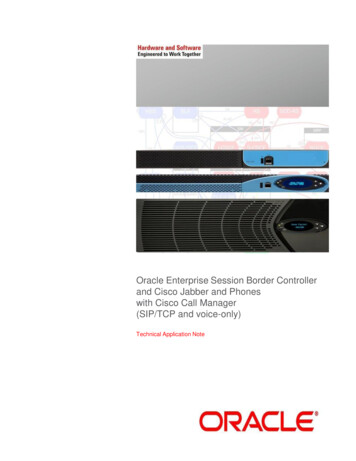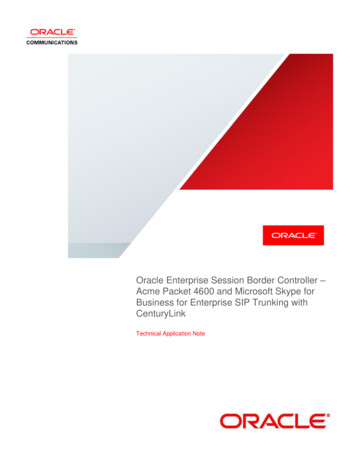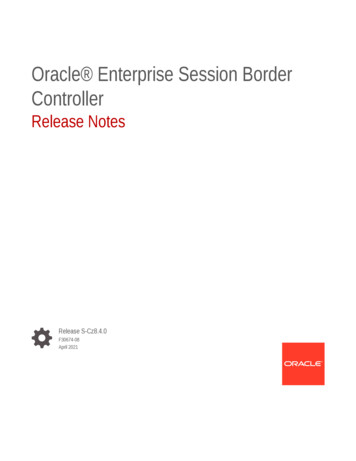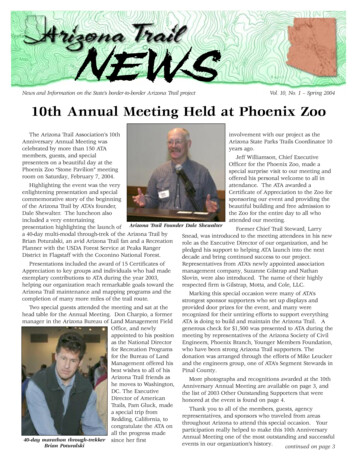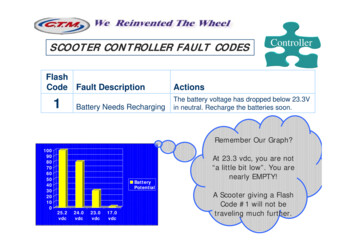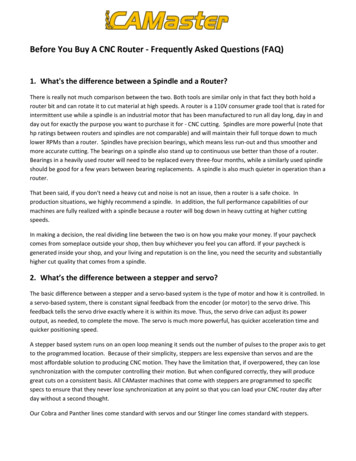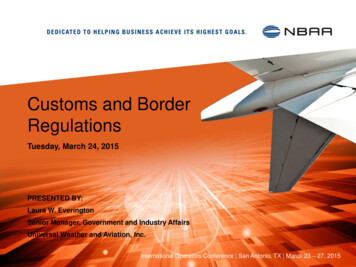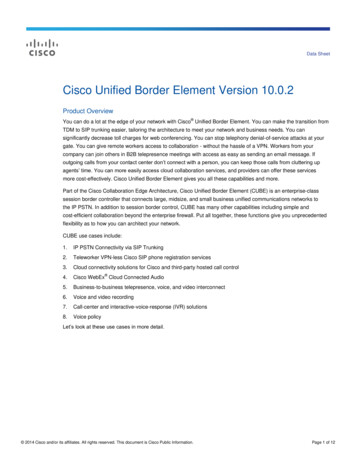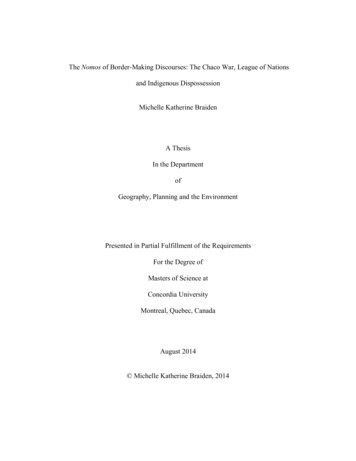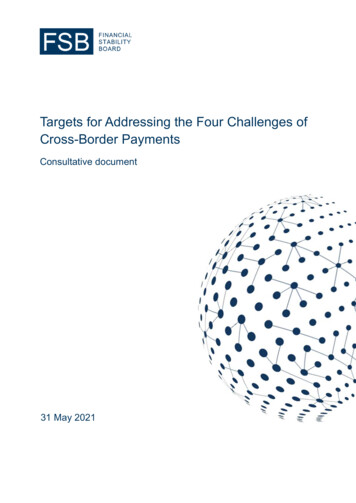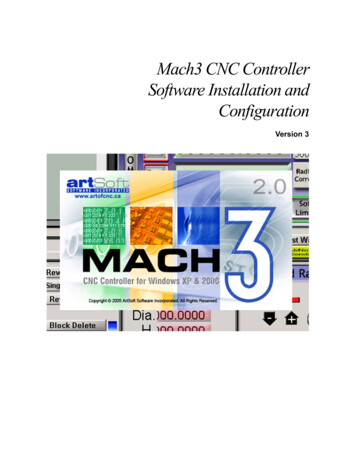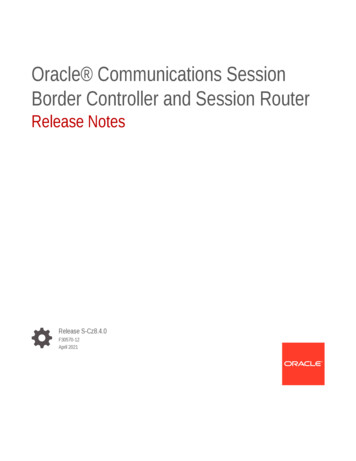
Transcription
Oracle Communications SessionBorder Controller and Session RouterRelease NotesRelease S-Cz8.4.0F30570-12April 2021
Oracle Communications Session Border Controller and Session Router Release Notes, Release S-Cz8.4.0F30570-12Copyright 2007, 2021, Oracle and/or its affiliates.This software and related documentation are provided under a license agreement containing restrictions onuse and disclosure and are protected by intellectual property laws. Except as expressly permitted in yourlicense agreement or allowed by law, you may not use, copy, reproduce, translate, broadcast, modify, license,transmit, distribute, exhibit, perform, publish, or display any part, in any form, or by any means. Reverseengineering, disassembly, or decompilation of this software, unless required by law for interoperability, isprohibited.The information contained herein is subject to change without notice and is not warranted to be error-free. Ifyou find any errors, please report them to us in writing.If this is software or related documentation that is delivered to the U.S. Government or anyone licensing it onbehalf of the U.S. Government, then the following notice is applicable:U.S. GOVERNMENT END USERS: Oracle programs (including any operating system, integrated software,any programs embedded, installed or activated on delivered hardware, and modifications of such programs)and Oracle computer documentation or other Oracle data delivered to or accessed by U.S. Governmentend users are "commercial computer software" or "commercial computer software documentation" pursuantto the applicable Federal Acquisition Regulation and agency-specific supplemental regulations. As such,the use, reproduction, duplication, release, display, disclosure, modification, preparation of derivative works,and/or adaptation of i) Oracle programs (including any operating system, integrated software, any programsembedded, installed or activated on delivered hardware, and modifications of such programs), ii) Oraclecomputer documentation and/or iii) other Oracle data, is subject to the rights and limitations specified in thelicense contained in the applicable contract. The terms governing the U.S. Government’s use of Oracle cloudservices are defined by the applicable contract for such services. No other rights are granted to the U.S.Government.This software or hardware is developed for general use in a variety of information management applications.It is not developed or intended for use in any inherently dangerous applications, including applications thatmay create a risk of personal injury. If you use this software or hardware in dangerous applications, then youshall be responsible to take all appropriate fail-safe, backup, redundancy, and other measures to ensure itssafe use. Oracle Corporation and its affiliates disclaim any liability for any damages caused by use of thissoftware or hardware in dangerous applications.Oracle and Java are registered trademarks of Oracle and/or its affiliates. Other names may be trademarks oftheir respective owners.Intel and Intel Inside are trademarks or registered trademarks of Intel Corporation. All SPARC trademarks areused under license and are trademarks or registered trademarks of SPARC International, Inc. AMD, Epyc,and the AMD logo are trademarks or registered trademarks of Advanced Micro Devices. UNIX is a registeredtrademark of The Open Group.This software or hardware and documentation may provide access to or information about content, products,and services from third parties. Oracle Corporation and its affiliates are not responsible for and expresslydisclaim all warranties of any kind with respect to third-party content, products, and services unless otherwiseset forth in an applicable agreement between you and Oracle. Oracle Corporation and its affiliates will notbe responsible for any loss, costs, or damages incurred due to your access to or use of third-party content,products, or services, except as set forth in an applicable agreement between you and Oracle.
ContentsAbout this GuideMy Oracle SupportviRevision History1Introduction to S-Cz8.4.0Supported Platforms1-1Supported Physical Platforms1-1Supported Private Virtual Infrastructures and Public Clouds1-2Requirements for Machines on Private Virtual Infrastructures1-4PCIe Transcoding Card Requirements1-6Oracle Communications Session Router Recommendations for Netra andOracle Servers1-6Image Files and Boot Files1-6Image Files for Customers Requiring Lawful Intercept1-7Boot Loader Requirements1-8Setup Product1-8Upgrade Information1-9Upgrade Checklist1-10Upgrade and Downgrade Caveats1-10Feature EntitlementsEncryption for Virtual SBC1-161-17System Capacities1-17Transcoding Support1-17Coproduct Support1-19TLS Cipher Updates1-20Documentation Changes1-21Behavioral Changes1-22Patches Included in This Release1-23Supported SPL Engines1-24iii
2New Features3Interface Changes4ACLI Configuration Element Changes3-1ACLI Command Changes3-6Accounting Changes3-6SNMP/MIB Changes3-10Alarms3-11HDR3-11Caveats and Known IssuesKnown Issues4-1Caveats and Limitations4-26Limitations Removed4-30iv
About this GuideThe Oracle Session Border Controller (SBC) family of products are designed toincrease security when deploying Voice over IP (VoIP) or Unified Communications(UC) solutions. Properly configured, Oracle’s SBC family helps protect IT assets,safeguard confidential information, and mitigate risks—all while ensuring the highservice levels which users expect from the corporate phone system and the publictelephone network.Documentation SetThe following table lists related documentation.Document NameDocument DescriptionAcme Packet 3900 HardwareInstallation GuideContains information about the components andinstallation of the Acme Packet 3900.Acme Packet 4600 HardwareInstallation GuideContains information about the components andinstallation of the Acme Packet 4600.Acme Packet 6100 HardwareInstallation GuideContains information about the components andinstallation of the Acme Packet 6100.Acme Packet 6300 HardwareInstallation GuideContains information about the components andinstallation of the Acme Packet 6300.Acme Packet 6350 HardwareInstallation GuideContains information about the components andinstallation of the Acme Packet 6350.Release NotesContains information about the currentdocumentation set release, including new featuresand management changes.ACLI Configuration GuideContains information about the administration andsoftware configuration of the Service ProviderSession Border Controller (SBC).ACLI Reference GuideContains explanations of how to use the ACLI, asan alphabetical listings and descriptions of all ACLIcommands and configuration parameters.Maintenance and TroubleshootingGuideContains information about SBC logs, performanceannouncements, system management, inventorymanagement, upgrades, working with configurations,and managing backups and archives.MIB Reference GuideContains information about Management InformationBase (MIBs), Oracle Communication's enterpriseMIBs, general trap information, including specificdetails about standard traps and enterprise traps,Simple Network Management Protocol (SNMP) GETquery information (including standard and enterpriseSNMP GET query names, object identifier namesand numbers, and descriptions), examples of scalarand table objects.v
About this GuideDocument NameDocument DescriptionAccounting GuideContains information about the SBC’s accountingsupport, including details about RADIUS andDiameter accounting.HDR Resource GuideContains information about the SBC’s Historical DataRecording (HDR) feature. This guide includes HDRconfiguration and system-wide statistical information.Administrative Security EssentialsContains information about the SBC’s support for itsAdministrative Security license.SBC Family Security GuideContains information about security considerationsand best practices from a network and applicationsecurity perspective for the SBC family of products.Installation and Platform PreparationGuideContains information about upgrading system imagesand any pre-boot system provisioning.Call Traffic Monitoring GuideContains information about traffic monitoring andpacket traces as collected on the system. This guidealso includes WebGUI configuration used for the SIPMonitor and Trace application.FIPS Compliance GuideContains conceptual and procedural information forconfiguration using the tools and protocols requiredto manage call traffic on the SBC.HMR Resource GuideContains information about configuring and usingHeader Manipulation Rules to manage service traffic.TSCF SDK GuideContains information about the client-side SDK thatfacilitates the creation of secure tunnels between aclient application and the TSCF of the SBC.REST API GuideContains information about the supported REST APIsand how to use the REST API interface.Documentation AccessibilityFor information about Oracle's commitment to accessibility, visit theOracle Accessibility Program website at http://www.oracle.com/pls/topic/lookup?ctx acc&id docacc.My Oracle SupportMy Oracle Support (https://support.oracle.com) is your initial point of contact for allproduct support and training needs. A representative at Customer Access Support(CAS) can assist you with My Oracle Support registration.Call the CAS main number at 1-800-223-1711 (toll-free in the US), or call the OracleSupport hotline for your local country from the list at l. When calling, make the selections in the sequence shown belowon the Support telephone menu:1.Select 2 for New Service Request.2.Select 3 for Hardware, Networking, and Solaris Operating System Support.3.Select one of the following options: For technical issues such as creating a new Service Request (SR), select 1. For non-technical issues such as registration or assistance with My OracleSupport, select 2.vi
About this GuideYou are connected to a live agent who can assist you with My Oracle Supportregistration and opening a support ticket.My Oracle Support is available 24 hours a day, 7 days a week, 365 days a year.Emergency ResponseIn the event of a critical service situation, emergency response is offered by theCustomer Access Support (CAS) main number at 1-800-223-1711 (toll-free in theUS), or call the Oracle Support hotline for your local country from the list at l. The emergency response providesimmediate coverage, automatic escalation, and other features to ensure that thecritical situation is resolved as rapidly as possible.A critical situation is defined as a problem with the installed equipment that severelyaffects service, traffic, or maintenance capabilities, and requires immediate correctiveaction. Critical situations affect service and/or system operation resulting in one orseveral of these situations: A total system failure that results in loss of all transaction processing capability Significant reduction in system capacity or traffic handling capability Loss of the system's ability to perform automatic system reconfiguration Inability to restart a processor or the system Corruption of system databases that requires service affecting corrective actions Loss of access for maintenance or recovery operations Loss of the system ability to provide any required critical or major troublenotificationAny other problem severely affecting service, capacity/traffic, billing, and maintenancecapabilities may be defined as critical by prior discussion and agreement with Oracle.Locate Product Documentation on the Oracle Help Center SiteOracle Communications customer documentation is available on the web at the OracleHelp Center (OHC) site, http://docs.oracle.com. You do not have to register to accessthese documents. Viewing these files requires Adobe Acrobat Reader, which can bedownloaded at http://www.adobe.com.1.Access the Oracle Help Center site at http://docs.oracle.com.2.Click Industries.3.Under the Oracle Communications sub-header, click the Oracle Communicationsdocumentation link.The Communications Documentation page appears. Most products covered bythese documentation sets appear under the headings "Network Session Deliveryand Control Infrastructure" or "Platforms."4.Click on your Product and then Release Number.A list of the entire documentation set for the selected product and release appears.5.To download a file to your location, right-click the PDF link, select Save target as(or similar command based on your browser), and save to a local folder.vii
About this GuideAccess to Oracle SupportOracle customers that have purchased support have access to electronic supportthrough My Oracle Support. For information, visit http://www.oracle.com/pls/topic/lookup?ctx acc&id info or visit http://www.oracle.com/pls/topic/lookup?ctx acc&id trsif you are hearing impaired.viii
Revision HistoryThis section provides a revision history for this document.DateRevisionJune 2020 Initial releaseJune 2020 Corrects product name in book titleUpdates EVS/HW transcoding noteUpdates Known Issue list for p1Updates ethernet controller list for virtualmachinesCorrects format error in fixed knownissues table July 2020 Updates Caveats and Limitations sectionUpdates SDM Version SupportSept 2020 Updates for release S-Cz8.4.0p2Updates Oracle Communications SessionMonitor compatibilityOct 2020 Updates for S-Cz8.4.0p3 release.Adds note in Co-Product Support sectionfor new XSD requirement.Removes SILK from Pooled Transcodingcaveats list.Adds conditional logging upgrade caveat. Nov 2020 Adds IKE caveat.Notes behavioral changes with AcmeUser-Class VSA.Adds "Connection Failures with SSH/SFTP Clients" in the Upgrade andDowngrade CaveatsDec 2020 Removes Small Footprint VNF note.Adds alarm on core config change in HAenvironmentsMarch 2021 Updates document, including "NewFeatures" chapter and "Caveats andKnown Issues" for S-Cz8.4.0p4 release.Adds G.723 to vSBC list.Adds MSRP and Transcoding caveats. April 2021 Updates the "New Features" topic for theS-Cz8.4.0p5 release.Updates the "Known Issues" topic for theS-Cz8.4.0p5 release.ix
1Introduction to S-Cz8.4.0The Oracle Communications Session Border Controller Release Notes provides thefollowing information about S-Cz8.4.0 release: Specifications of supported platforms, virtual machine resources, and hardwarerequirements Overviews of the new features and enhancements Summaries of known issues, caveats, limitations, and behavioral changes Details about upgrades and patch equivalency Notes about documentation changes, behavioral changes, and interface changesSupported PlatformsThe Oracle Communications Session Border Controller (OCSBC) can run on a varietyof physical and virtual platforms. It can also be run in public cloud environments. Thissection lists all supported platforms and high level requirements.Supported Physical PlatformsThe Oracle Communications Session Border Controller can be run on the followinghardware platforms.Acme Packet PlatformsThe S-Cz8.4.0 version of the OCSBC supports the following platforms: Acme Packet 3900 Acme Packet 4600 Acme Packet 6100 Acme Packet 6300 Acme Packet 6350 Virtual PlatformsThe S-Cz8.4.0 version of the OCSR supports the following platforms: Acme Packet 4600 Acme Packet 6100 Acme Packet 6300 Netra Server X5-2 Oracle Server X7-2 Oracle Server X8-21-1
Chapter 1Supported Platforms Virtual PlatformsSupported Private Virtual Infrastructures and Public CloudsThe OCSBC can be run on the following Private Virtual Infrastructures, which includeprivate server/hypervisor platforms as well as private clouds based on architecturessuch as VMware or Openstack.Note:The OCSBC does not support automatic, dynamic disk resizing.Supported Hypervisors for Private Virtual InfrastructuresOracle supports installation of OCSBC on the following hypervisors: KVM: Linux kernel version 3.10.0-123 or later, with KVM/QEMU (2.9.0 16 or later)and libvirt (3.9.0 14 or later) VMware: vSphere ESXi Version 6.5 or later, up to, but not including version 7.0) XEN: Release 4.4 or laterCompatibility with OpenStack Private Virtual InfrastructuresOracle distributes Heat templates for the Newton and Pike versions of OpenStack.Use the Newton template when running either the Newton or Ocata versions ofOpenStack. Use the Pike template when running Pike or a later version of OpenStack.Supported Public Cloud PlatformsIn S-Cz8.4.0 the OCSBC can be run on the following public cloud platforms. For moreinformation, see "New Features". Oracle Cloud Infrastructure (OCI) - After deployment, you can change the shape ofyour machine by, for example, adding disks and interfaces. OCI Cloud Shapes andoptions validated in this release are listed in the table d1.88/16822YVM.Standard1.16 22Y1622YVM.Standard2.16 16/32Networking using image mode [SR-IOV mode - Native] is supported on OCI. PVand Emulated modes are not currently supported. Amazon Web Services (EC2) - This table lists the AWS (ECs) instance sizesthat apply to the OCSBC. Enhanced networking [SR-IOV mode – i82599 VF] issupported for the VM shapes listed below. ENA is not currently supported.1-2
Chapter 1Supported Platforms Instance TypevCPUsMemory (GB)Max 6648Microsoft Azure - Size types define architectural differences and cannot bechanged after deployment.During deployment you choose a size for the OCSBC, based on pre-packagedAzure sizes. After deployment, you can change the detail of these sizes to, forexample, add disks or interfaces. Azure presents multiple size options for multiplesize types.For higher performance and capacity on media interfaces, use the Azure CLI tocreate a network interface with accelerated networking.This following table lists the Azure instance sizes that you can use for the OCSBC.Oracle supports only v2 size types.Note:The OCSBC does not support Data Disks deployed over any Azure instancesizes.SizevCPUsMemoryMax NICsStandard F8s v28164Standard F16s v216324Note:v2 instances have hyperthreading enabled.DPDK ReferenceThe OCSBC relies on DPDK for packet processing and related functions. You mayreference the Tested Platforms section of the DPDK release notes available at https://doc.dpdk.org. This information can be used in conjunction with this Release Notesdocument for you to set a baseline of: CPU Host OS and version NIC driver and version NIC firmware version1-3
Chapter 1Supported PlatformsNote:Oracle only qualifies a specific subset of platforms. Not all the hardwarelisted as supported by DPDK is enabled and supported in this software.The DPDK version used in this release is: 19.11 19.11.2 (S-Cz8.4.0p2 and later)Requirements for Machines on Private Virtual InfrastructuresA Virtual Session Border Controller (VSBC) requires the CPU core, memory, disk size,and network interfaces specified for operation. Deployment details, such as the use ofdistributed DoS protection, dictate resource utilization beyond the defaults.Default VSBC ResourcesVM resource configuration defaults to the following: 4 CPU Cores 8 GB RAM 20 GB hard disk (pre-formatted) 8 interfaces as follows:–1 for management (wancom0 )–2 for HA (wancom1 and 2)–1 spare–4 for mediaInterface Host Mode for Private Virtual InfrastructuresThe OCSBC VNF supports interface architectures using Hardware Virtualization Mode- Paravirtualized (HVM-PV): ESXi - No manual configuration required. KVM - HVM mode is enabled by default. Specifying PV as the interface typeresults in HVM plus PV. XEN (OVM) - The user must configure HVM PV mode.Supported Interface Input-Output Modes for Private Virtual Infrastructures Para-virtualized SR-IOV PCI Passthrough Emulated - Emulated is supported for management interfaces only.1-4
Chapter 1Supported Plat
The Oracle Session Border Controller (SBC) family of products are designed to increase security when deploying Voice over IP (VoIP) or Unified Communications (UC) solutions. Properly configured, Oracle’s SBC family helps protect IT assets, safeguard confidential in
